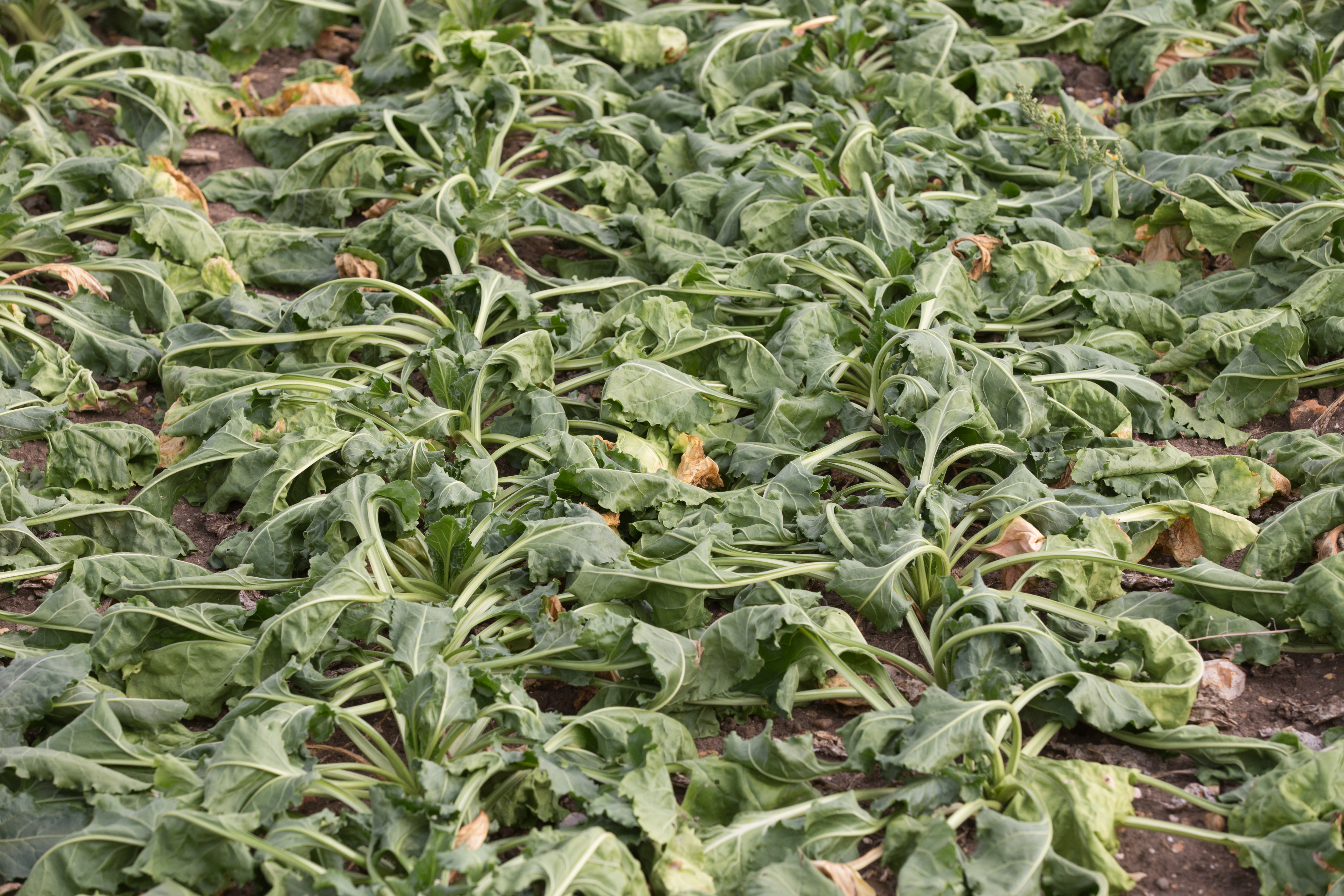Recent research has shed more light on the interaction seaweed extract has with crops and how it can bring best results. CPM explores the developments.
During water stress periods like the summer of 2018 products containing seaweed kept the nutrient pump moving.
By Andrew Blake
Seaweed has long been applied to fields by farmers in coastal areas, who claim it has clear crop-enhancing properties. But pin-pointing exactly what those are and more significantly how they work has taken time. Now it seems researchers are homing in on their key function, namely countering so-called abiotic stress.
Crop losses from abiotic stresses such as drought and extreme temperatures can far exceed those caused by biotic stresses such as insect and disease attacks, according to FMC Technical Manager Plant Health, Charlie Bannister.
“A number of researchers have pointed out the effects of abiotic stress in terms of lost yield and quality.”
One notable paper on the subject, authored by Elizabeth Bray and published in 2000, highlighted global yields for various crops and the losses from abiotic and biotic stresses.

Up to 70% of global yield losses are due to abiotic stresses, such as heat, drought and cold.
“In all cases losses from abiotic stress were far greater,” says Charlie.
“Abiotic stress events significantly limit crop productivity worldwide,” adds John O’Sullivan of biostimulant manufacturer BioAtlantis, based in Ireland.
“Crops exposed to abiotic stress factors don’t reach their full genetic potential. Depending on the crop and geographical area, up to 70% of global yield losses are due to abiotic stresses such as heat, drought and cold.”
Seaweed, in particular the brown plant Ascophyllum nodosum which grows on the middle shore areas of the North Atlantic from the Arctic to Portugal, has been harvested for many generations.
“It’s been used as a fertiliser for centuries, and more recently extracts have been used as liquid crop feeds,” says Charlie. “But it’s suffered ‘false starts’ through over-selling and a lack of understanding of the science behind it.”
Heavy marketing of seaweed products over decades has led to a considerable level of confusion and inaccurate claims regarding their efficacy, adds John.
Initially it was thought that the plant hormones – auxins, cytokinins, gibberellins and betaines – which A. nodosum extracts contain were driving the crop benefits.
“However, we now know that any growth hormones that are present in these extracts are at such negligible quantities that they’re rendered ineffective. Moreover, the recommended application rates are too low to cause any effect that could be attributable to them.
“Compounding this, growth hormones in seaweed readily break down in the presence of light, heat and oxidizing conditions when exposed in the field. As such, the ‘growth hormone’ theory of how A. nodosum extracts work lacks adequate scientific support.”
Another problem has been poor advice on how and when to apply seaweed extracts, he maintains.
“In particular, the advice to apply these products ‘little and often’ lacks both meaning and precision and provides no guarantee in relation to product efficacy.
“As a result, a degree of scepticism has emerged as to whether or not A. nodosum extracts actually work, and whether or not they provide a return on investment to the grower.”
The latest emerging research from Germany shows that the extracts are most effective in the context of abiotic stress mitigation rather than as broad spectrum growth stimulants, says John.
“A. nodosum contains high levels of a number of key compounds that may induce abiotic stress tolerance in plants, including phlorotannins and the polysaccharide, fucoidan.”
Such compounds are anti-oxidants, he explains. “When plants become stressed they produce Reactive Oxygen Species (ROS).
“There are numbers of compounds which could be classed as ROS, and which are highly reactive.” That property means they have a tendency to cause significant damage to membranes, cell walls and other structures in plants.
“When stress occurs, be it biotic or abiotic, these potentially very damaging ROS can arise.
“In some ways that can be a good thing because it acts as a signal for the plant to initiate its defence strategies. ROS can also act as a cordon sanitaire around the ingress of plant disease, but left unchecked significant damage will occur.”
Charlie believes the anti-oxidants in A. nodosum link with or essentially smother the ROS and so neutralise their reactivity.
John says that it’s also emerging that the efficacy of A. nodosum extracts in abiotic stress mitigation strongly depends on the extraction method and the molecular size of the bioactive compounds, such as fucoidan and phlorotannins, which are involved.
“BioAtlantis has developed a highly concentrated A. nodosum extract (500g/l), Super Fifty, which contains a number of distinct polysaccharide compounds.
“Research is showing that these polysaccharides have the capacity to prime and activate signalling pathways and bring about positive responses in plants under abiotic stress conditions such as cold, drought and heat stress.”
He says that from working with experts from the University of Potsdam in Germany the firm now has a better understanding of Super Fifty’s modes of action and has developed a “stress mitigation and plant-strengthening technology” based on pre-treating crops with it.
“This research was conducted as part of an EU Horizon 2020 project called ‘CropStrengthen’, and the findings are due for publication within the next three to six months in a number of high impact peer-reviewed scientific journals.”
The papers are largely focused on methods of counteracting Reactive Oxygen Species (ROS), as a means of mitigating against abiotic stress in crops, he notes.
Treated crops pull through hot dry summer
Procam agronomist Ian Jackson advises growers in East Anglia on crops grown on silt, heavy clay and organic soils.
“I’ve used seaweed products for many years as a growth stimulant. They have added benefits of boosting the plants’ own defence mechanisms,” he says.
In contrast to John’s view he believes the growth hormones such products contain do have a beneficial role.
“During water stress periods like the summer of 2018 products containing seaweed kept the nutrient pump moving in the plant by supplying gibberellin, auxin, cytokinins and betains.
“Once production of these hormones slows or stops because of stress, the flow of nutrients in the plant stops, the sugars build within it and transpiration slows causing abiotic stress symptoms,” explains Ian.
“Along with a tailored nutrient package, treated crops carried on growing during water deficit until the rain came.
“Wheat was the stand-out performer last year with the seaweed nutrient package. The crops stayed greener longer with a 15-20% better green leaf index. Average yields were about 10.3t/ha with the water retentive soils giving up to 11t/ha.
“The specific weights, hovering around 80kg/hl, made the difference showing that the plants had time to fill the two lower and upper grains.
“The SDHI chemistry mixed with seaweed worked well both to protect the plant from extremes of weather, and relieve heat and water stress.
“Sugar beet surprised everyone when harvested after the programmed approach – it kept the green leaf area ready to make the most of ideal growing conditions once the temperatures eased.
“Following the extreme conditions, the yields of later-lifted beet crops have equalled those of good years, and many have exceeded them. The crops lost six weeks of growing at what was considered the peak bulking stage, but made up with the perfect conditions into Nov.”
Opinions differ on the role of hormones
The views expressed by John O’Sullivan and Ian Jackson on the plant-enhancing role of the hormones contained in A. nodosum show that the picture remains unclear, notes Charlie Bannister. So what’s actually going on?
“The plant hormone story is a bit complex,” he says. “The general perception at present is that some of the effects of ascophyllum are due to the levels of plant hormones within the seaweed itself.”
However a scientific research paper published in June 2012 in the Journal of Plant Growth Regulation analysed levels of plant hormones within different sources from various locations and found they contained varying amounts, he notes.
“The authors concluded that the effects of asco after application aren’t due to the levels of exogenous hormones in the asco itself, but that the application could well increase the levels of endogenous hormones in the treated plants.
“So the truth probably lies somewhere between the two opinions and the currently held general perception,” he says.
Cropstrengthen research highlights gene link
The idea behind the priming technology involves pre-treatment of a crop with a specific A. nodosum extract (Super Fifty). This makes the plants more tolerant of future stress exposures, explains Prof Dr Bernd Müeller-Röeber of the University of Potsdam.
“Plants treated with the biostimulant are better prepared – or in scientific jargon ‘primed’ – to respond to an upcoming abiotic stress challenge, like drought.”
Studies within the EU-funded CropStrengthen project found that in Arabidopsis thaliana (thale cress, a widely-used model plant) and in diverse crops, the enhanced stress tolerance triggered by Super Fifty treatment is connected to the action of distinct genes, he says.
“This result represents a big step forward towards our understanding of how biostimulants affect plant processes to increase their stress tolerance.
“An important task for the future will be to unravel the exact contribution of those genes to the stress tolerance mechanisms triggered by the biostimulant.
“Unravelling this will also help us to breed new crop varieties that are even better suited to interact with the biostimulant for improved abiotic stress tolerance.
“So this research is of great importance for breeding varieties that can better cope with environmental impacts due to climate change,” concludes Bernd.
Research briefing
To help growers get the best out of technology used in the field, manufacturers continue to invest in R&D at every level, from the lab to extensive field trials. CPM Research Briefings provide not only the findings of recent research, but also an insight into the technology, to ensure a full understanding of how to optimise its use.
CPM would like to thank FMC Agro for sponsoring this Research Briefing and for providing privileged access to staff and material used to help bring it together.
FMC supplies an extensive range of foliar nutrition products and biostimulants. SeaMaxx contains Ascophyllum nodosum together with nitrogen, phosphorus, potassium and a carefully balanced blend of plant-available micronutrients. Applied at the correct time, it provides localised increases in hormone levels (particularly cytokinins) which stimulate the plant’s metabolism. This encourages nutrient uptake and carbohydrate production. The presence of additional N,P,K and micronutrients helps to optimize the plant’s nutrient status at a time of rapid growth.




